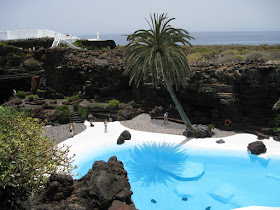The Colonia Guell is just east of central Barcelona (and north of the airport). It was the idea of Eusubi Guell who was the owner of a textile mill in Barcelona in the late 1890s. (Eusubi was also the patron of the Gaudi-designed Park Guell.) During an expansion of the business, he decided to move the company outside of the city to an estate he purchased. His goal was to create a positive environment and improved living conditions for his employees by having company town where the workers could live in nice housing, have good schools, and access to leisure and cultural activities, including religious services at the Gaudi-designed church.
Excluding the beautiful church, the town has some great architecture both in the houses and the factory buildings and is worth a visit. There are a bunch of modernist (among others) details to be found and it's easy walk around the whole town in a couple of hours.
When walking into the town from the nearby train station, you first see the walled factory, which I believe, unfortunately for a factory-tour glutton (me), you are not able to get into. It looks as though some of the buildings have been modernized and are in use and others look like they were knocked down at some point. The buildings are very cool and are constructed from brick in the style of the time.


The first house (at least I believe it is a house) you see when getting into the housing-area of town is this gem. There was no plaque that I could find to get more information. The highlights include the cool style, the interesting chimneys, and the sunken garden in the front (left side of this photo).

Most of the houses are town-house (row-house) style. One of Esubi's desires was that employees wouldn't have to live in an apartment-building setting that was common in the factory towns of the time. There are various styles but most are two-story and some have a small front patio.


As with a couple of the above photos and the photo below, it appears that management also "benefited" from the social experiment that is Colonia Guell. This one is a particular gem...

And finally, as one of two official photographers on the trip, and the writer of this blog, I get to share this photo of me "just taking a timed photo" and then jumping on the laps of my unsuspecting friends while waiting for the train home. Thanks for the great day Diana, Gema, Andrea, and David. What's next on the to-do list?


















































